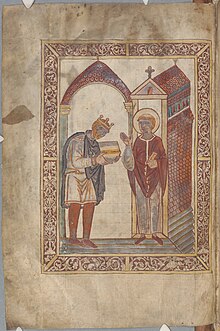| Battle of Brunanburh | |||||||
|---|---|---|---|---|---|---|---|
| Part of the Viking invasions of England | |||||||
 A portrait of Æthelstan presenting a book to Saint Cuthbert | |||||||
| |||||||
| Belligerents | |||||||
| Kingdom of England |
Kingdom of Dublin Kingdom of Alba Kingdom of Strathclyde | ||||||
| Commanders and leaders | |||||||
| Æthelstan |
Olaf Guthfrithson Constantine II Owen I | ||||||
The Battle of Brunanburh was fought in 937 between Æthelstan, King of England, and an alliance of Olaf Guthfrithson, King of Dublin; Constantine II, King of Scotland; and Owain, King of Strathclyde. The battle is sometimes cited as the point of origin for English national identity: historians such as Michael Livingston argue that "the men who fought and died on that field forged a political map of the future that remains, arguably making the Battle of Brunanburh one of the most significant battles in the long history not just of England, but of the whole of the British Isles."[1]
Following an unchallenged invasion of Scotland by Æthelstan in 934, possibly launched because Constantine had violated a peace treaty, it became apparent that Æthelstan could be defeated only by an alliance of his enemies. Olaf led Constantine and Owen in the alliance. In August 937 Olaf and his army sailed from Dublin[2] to join forces with Constantine and Owen, but they were routed in the battle against Æthelstan. The poem Battle of Brunanburh in the Anglo-Saxon Chronicle recounts that there were "never yet as many people killed before this with sword's edge ... since the east Angles and Saxons came up over the broad sea".
Æthelstan's victory preserved the unity of England. The historian Æthelweard wrote around 975 that "[t]he fields of Britain were consolidated into one, there was peace everywhere, and abundance of all things". Alfred Smyth has called the battle "the greatest single battle in Anglo-Saxon history before Hastings". The site of the battle is unknown; many possible locations have been proposed by scholars.
- ^ Livingston 2011, p. 1.
- ^ Anonymous. ”Annals of Clonmacnoise". In The Battle of Brunanburh. A Casebook. Ed. Michael Livingston. University of Exeter Press. 2011. pp. 152–153